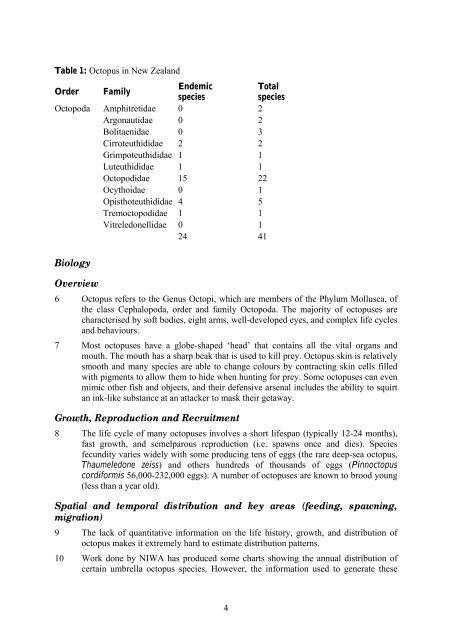Information briefs and risk analyses for species under consideration ...
Information briefs and risk analyses for species under consideration ...
Information briefs and risk analyses for species under consideration ...
You also want an ePaper? Increase the reach of your titles
YUMPU automatically turns print PDFs into web optimized ePapers that Google loves.
Table 1: Octopus in New Zeal<strong>and</strong><br />
Order Family<br />
Endemic<br />
<strong>species</strong><br />
Total<br />
<strong>species</strong><br />
Octopoda Amphitretidae 0 2<br />
Argonautidae 0 2<br />
Bolitaenidae 0 3<br />
Cirroteuthididae 2 2<br />
Grimpoteuthididae 1 1<br />
Luteuthididae 1 1<br />
Octopodidae 15 22<br />
Ocythoidae 0 1<br />
Opisthoteuthididae 4 5<br />
Tremoctopodidae 1 1<br />
Vitreledonellidae 0 1<br />
24 41<br />
Biology<br />
Overview<br />
6 Octopus refers to the Genus Octopi, which are members of the Phylum Mollusca, of<br />
the class Cephalopoda, order <strong>and</strong> family Octopoda. The majority of octopuses are<br />
characterised by soft bodies, eight arms, well-developed eyes, <strong>and</strong> complex life cycles<br />
<strong>and</strong> behaviours.<br />
7 Most octopuses have a globe-shaped ‘head’ that contains all the vital organs <strong>and</strong><br />
mouth. The mouth has a sharp beak that is used to kill prey. Octopus skin is relatively<br />
smooth <strong>and</strong> many <strong>species</strong> are able to change colours by contracting skin cells filled<br />
with pigments to allow them to hide when hunting <strong>for</strong> prey. Some octopuses can even<br />
mimic other fish <strong>and</strong> objects, <strong>and</strong> their defensive arsenal includes the ability to squirt<br />
an ink-like substance at an attacker to mask their getaway.<br />
Growth, Reproduction <strong>and</strong> Recruitment<br />
8 The life cycle of many octopuses involves a short lifespan (typically 12-24 months),<br />
fast growth, <strong>and</strong> semelparous reproduction (i.e. spawns once <strong>and</strong> dies). Species<br />
fecundity varies widely with some producing tens of eggs (the rare deep-sea octopus,<br />
Thaumeledone zeiss) <strong>and</strong> others hundreds of thous<strong>and</strong>s of eggs (Pinnoctopus<br />
cordi<strong>for</strong>mis 56,000-232,000 eggs). A number of octopuses are known to brood young<br />
(less than a year old).<br />
Spatial <strong>and</strong> temporal distribution <strong>and</strong> key areas (feeding, spawning,<br />
migration)<br />
9 The lack of quantitative in<strong>for</strong>mation on the life history, growth, <strong>and</strong> distribution of<br />
octopus makes it extremely hard to estimate distribution patterns.<br />
10 Work done by NIWA has produced some charts showing the annual distribution of<br />
certain umbrella octopus <strong>species</strong>. However, the in<strong>for</strong>mation used to generate these<br />
4

















